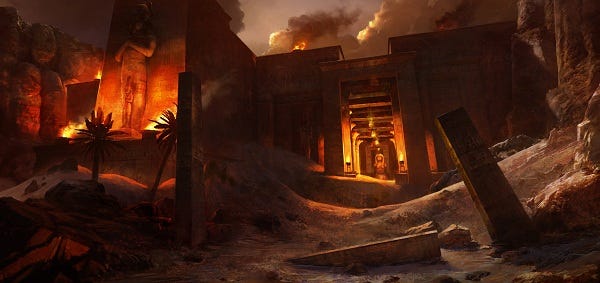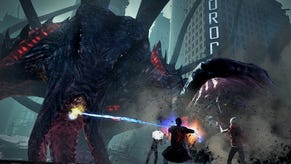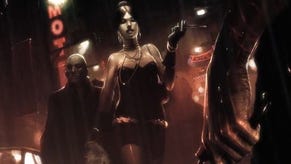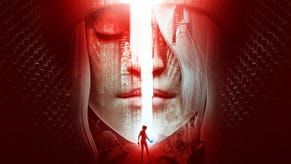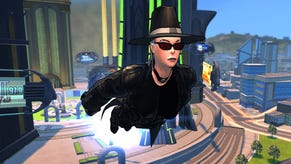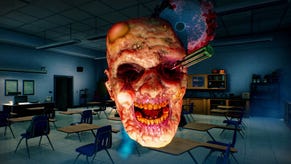Hands-On: The Secret World
Illuminating
I’ve spent the last couple of months searching the streets for signs of conspiracy, perhaps a Toynbee Tile or two bills from separate electricity companies who are clearly trying to con me out of every last penny. To resolve the troubled contents of my mind, I took another trip into The Secret World, where my every delusional thought seems quite ordinary in comparison to the oddities around me.
The last time I played, I had the chance to play through the beginnings of life as a Templar, which involved conversing with some rather slick individuals in Old London Town. My adventures continued in a grim Lovecraftian coastal town, where, with the help of some fellow journalists, I beat a star-spawned horror so hard that it whimpered and went back to sleep for another ten thousand years or so.
This time, I was one of the first outside Funcom to step into the hedonistic mindspace of an Illuminati recruit, exploring the cavernous, neo-disco trappings of a New York inverse-skyscraper. Let’s call it a crust-scraper, because it’s tickling the earth’s crust rather than the soles of the sky’s feet.
No New England horrors this time around as we skipped that part of the narrative and landed just outside a small desert town. The Illuminati had sent us to Egypt where, wouldn’t you just know it, a cult is attempting to raise a demon from the sands beneath which the blighter is sleeping.
The first thing that strikes me around the face like a boxer at a press conference is the different tone, in terms of characters and narrative. Where Solomon Island is quaffing Lovecraft, Poe and American folklore, Egypt is becoming Biblical, with a sense of high camp thrown in that reminds me of Indiana Jones and Universal’s horror era. Once again, it’s clear how much pop culture has been crammed into this game but it’s also becoming more obvious how it will be partitioned sensibly, with each hub borrowing and reimagining specific complementary portions of the many inspirations.
The Council of Venice are present and they add some gravity to the situation, talking about long-term consequences and the need to act sensibly and fast. The Council are mentioned a lot but I’ve had few encounters with them; they appear to have some kind of oversight over the three secret societies players can join but the Illuminati in particular seem quite dismissive of them.
In fact, the Illuminati seem fairly dismissive of everybody. Where the Templars are proud of their past and have a certain twisted honour, despite their willingness to look at the bigger picture and sacrifice innocents for the cause, the Illuminati, and particularly your deliciously uberhip handler, seem to quite enjoy being involved in The Secret World. They’re soaking in the glamour and delight of knowing what other people don’t know – you’ve almost definitely not heard of their favourite band, not because it only ever released one EP on limited edition cassette, but because it’s probably not even from this dimension.
The Templars seem to have a grave sense of responsibility; the Illuminati have a great sense of fashion. They’re also in on the cultural references that inform the game itself, riffing off computer games and films with the sly and intelligent humour that is one of the game’s hallmarks.
In Egypt, there is a definite friction between the instructions I’m receiving from headquarters and the situation on the ground. From the Illuminati there’s a strong message of “just get in, get the job done, screw the people on the ground, if they die it really doesn’t matter”. The Council of Venice, meanwhile, seem to be taking things a little harder. They’re the first organisation I’ve encountered that are overwhelmed and even saddened by the atrocities that are erupting around the globe.
I won’t go into detail about the plot of the Egyptian missions because so much of the fun lies in discovering them for yourself, but as a final word on narrative, this second viewing gave a much better idea of how the societies will interact. Not on the field of play – that’ll be mostly as teammates or PvP enemies – but in terms of the many stories of the world, which continue to be the most compelling portion of the game. Although, faction-specific missions aside, all of the societies will be performing the same tasks, the dialogue and textual updates provided throughout the journey give a different purpose to what you’re asked to do.
And, as before, the things that you are asked to do are varied and continue to avoid fetch quests. There are a few stumbling blocks where the instructions provided aren’t entirely clear, which led to gangs of hungover writers traipsing back and forth through sand dunes, being attacked by giant scorpions and cultists while occasionally turning to one another, their faces crumpled with anguish. Partly, that’s because The Secret World is trying to do things that haven’t been done in this type of game, at this scale. There are times when it feels more like a team-based adventure, with combat a distraction rather than a focus, as a group tries to think through a problem.
It reminds me of Mansions of Madness, the heavily themed horror boardgame in which players have to solve actual puzzles in the middle of a session, constructed randomly out of counters and card. It’s not something that they expect and it doesn’t come naturally at first. The same is true, I think, of teaming up in an MMORPG and reading mission text where every word matters, where exploration matters and where the answer is often in the details rather than in the grossly inconsistent inventory of a deranged rodent.
Then there’s the combat, which I enjoy far more in the dungeons than in the world itself. Partly that’s because the dungeons are linear so monsters are obstacles to pass rather than features of the landscape, respawning and pestering, but it’s also because dungeons are constructed to teach you new ways of fighting. Each new miniboss requires a different technique, usually involving teamwork, and the final boss brings all those techniques together, demanding communication, preparation, and sometimes a degree of patience.
It’s in the dungeons and the clashes at the end of a mission that a character’s skills really matter and there are nearly 600 of the sodding things so it’s not easy to pick and choose. I particularly enjoyed being able to make my hammer wielding lady grow to about ten feet tall and drag monsters toward her with magical chains while my puny little companions blasted away at them. The user interface is much improved since my last visit though and it’s now possible to build a deck of skills for a specific situation, and even to drag and drop that build on a team mate, allowing them to peruse it, learn from it and then use it if they have the requisite abilities.
Sharing tasks is easy too. If you’re on a mission and run into somebody who might be able to help, or who is simply at a loose end, the mission token can be dragged and dropped onto their character and they’ll have it lined up and ready. There are shades of a touchscreen interface, with icons and windows always malleable and movable, so it’s possible to set up your screen in any number of ways. It works well and even seems tied into the fiction, with the interface being an aspect of the character’s phone.
What else did I learn? To help with the investigation missions, Funcom have added an ingame internet browser. It’s something that had been hinted at and it makes perfect sense, both fitting with the interface and allowing for missions that encourage the seeking of outside knowledge. I also asked everybody that seemed even vaguely aware of the game’s existence if they could absolutely definitely clarify that the in-game shop would only allow for the purchase of cosmetic items. They all said ‘yes, that is the case’ and eventually started to look at me like I was insane.
The monster and character design continues to surprise and impress, with everything from giant bugs to madcap doctors and twitchy, drug-fuelled scientists. As on my previous visit, I've been confronted with a world packed with the contents of sharp and wild imaginations at play.
As for the rest, I spoke with creative director Ragnar Tornquist and asked a little more about how the team are looking to balance narrative and character progression, and why this story is best told in this particular genre of game. Look out for that in the coming days.
The Secret World will be released on June 19th.
